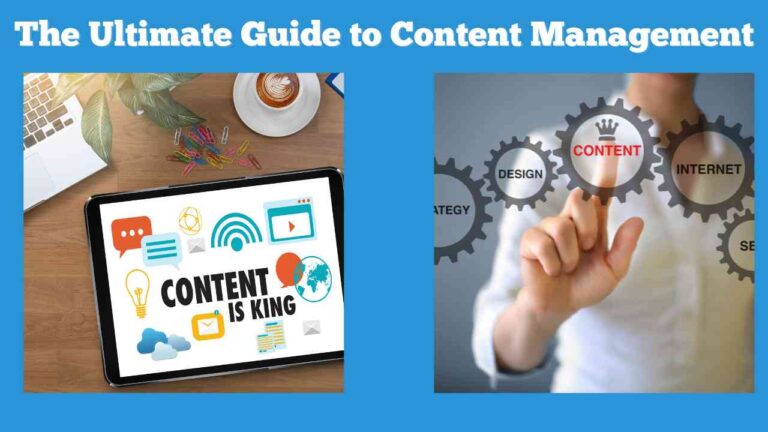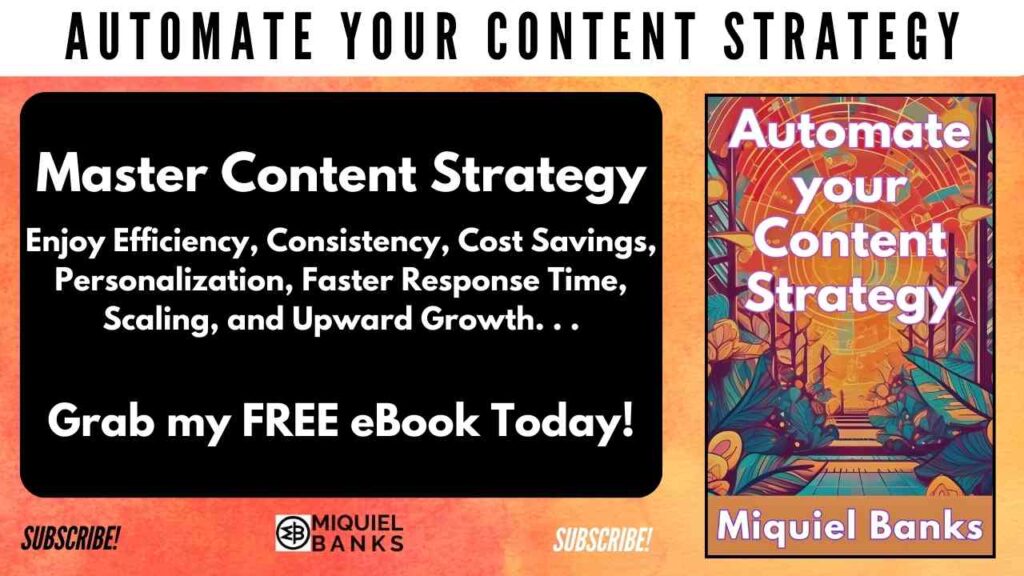Introduction
Managing content efficiently is crucial for small business owners striving for success and growth.
From creating engaging blogs to captivating social media posts, every piece of content represents the voice of your brand and connects with your audience.
How can you navigate this intricate process of content management while inspiring and empowering your business to thrive?
Join us on this transformative journey as we delve into the ultimate guide on how to effectively curate, organize, and distribute content that resonates with your audience and propels your business towards unprecedented success.
Through our expert insights and empowering strategies, we aim to equip you with the tools and knowledge needed to elevate your content management game and lead your business to new heights of achievement.
Understanding Content Management
Determining Your Content Needs
Before diving into content creation, it’s essential to identify what your business actually needs.
Start by asking yourself: What are the goals of my content?
Perhaps you aim to educate your audience, drive more traffic to your website, or establish thought leadership within your industry.
Understanding your objectives will inform not only the type of content you produce but also its tone, style, and medium.
Next, consider your audience.
- Who are they?
- What problems can your content solve for them?
By answering these questions, you can create a content roadmap that serves your audience’s needs while supporting your business goals.
Lastly, assess your resources.
- Do you have the necessary tools and skills in-house, or do you need to look externally?
Determining your content needs is a foundational step in crafting a strategy that’s both effective and sustainable.
Importance of Quality Content
Quality content is the cornerstone of any successful content management strategy.
But why does quality trump quantity?
High-quality content is more likely to engage your audience, build trust, and encourage sharing, which extends your brand’s reach.
It demonstrates your expertise and authority in your field, positioning your business as a reliable source of information.
Moreover, search engines favor quality content, meaning it can dramatically improve your search rankings and drive organic traffic to your site.
Think of your content as a long-term investment; well-crafted, timeless pieces can continue to draw in new customers and clients long after they’re published.
It’s about creating value for your audience—when they see the effort you put into your content, they’re more likely to invest in your products or services.
Remember, quality content not only attracts but also retains customers, fostering long-term relationships and loyalty.
Grasping Content Management Systems
Content Management Systems (CMS) are pivotal tools that help businesses organize and publish content with ease.
They serve as the backbone of your content strategy, allowing for streamlined workflow from creation to publication.
A CMS can help you maintain consistency across your content, which is key for brand recognition and messaging.
It’s not just about what you publish; it’s also about how and when you publish it.
With features like scheduling, version control, and access management, a CMS can significantly enhance productivity.
When choosing a CMS, consider factors such as user-friendliness, customization options, and integration capabilities with other tools you use.
The right CMS will fit seamlessly into your operations and scale with your business as it grows.
Understanding and utilizing a CMS effectively can transform your content management process, ensuring your content works as hard as you do for your business’s success.
Implementing Effective Content Strategy
Building a Comprehensive Content Plan
A comprehensive content plan is a blueprint for success in your digital marketing efforts.
To build this plan, start by defining clear, measurable goals.
What do you want to achieve with your content?
Increased brand awareness, lead generation, or customer education could be among your objectives.
Next, develop audience personas to tailor your content precisely to the needs and interests of your target market.
With goals and audience in mind, brainstorm content topics and types that will resonate and engage.
A diverse mix of blog posts, videos, infographics, and podcasts can cater to different preferences and increase your reach.
Set a realistic timeline and frequency for publishing content to maintain a consistent presence without overextending your resources.
Finally, establish metrics to track progress and success.
Your content plan should be a living document, regularly reviewed and adjusted as you respond to analytics data and evolving market conditions.
Creative Content Generation Ideas
When it comes to generating content, creativity is your greatest asset.
Think outside the box and explore various avenues for original content.
User-generated content, for example, can provide authentic testimonials and engage your community.
Hosting Q&A sessions, interviews with industry experts, or behind-the-scenes looks at your business can offer valuable insights and a human touch to your brand.
Don’t shy away from leveraging current events or trending topics to stay relevant and increase visibility.
Contests and challenges are also effective in sparking interest and interaction.
Another angle is educational content such as how-to guides, webinars, or e-books that position your brand as a helpful authority.
Remember, creative content generation isn’t just about what you create; it’s also about presenting your unique perspective and value proposition.
With each piece of content, you have an opportunity to strengthen your relationship with your audience and differentiate your brand.
Assessing Performance of Your Content
To ensure your content strategy is effective, it’s critical to assess the performance of your content.
Start by tracking key performance indicators (KPIs) such as website traffic, engagement rates, conversion rates, and social shares.
These metrics will tell you not only how many people are seeing your content, but also how they are interacting with it.
Use tools like Google Analytics and social media analytics to gather data.
Look for trends:
- Which types of content are resonating with your audience?
- What times of day do you get the most engagement?
- Which platforms are driving the most traffic?
Use these insights to refine your strategy, investing more in high-performing content types and tweaking or discarding those that underperform.
Remember, assessing content performance is an ongoing process.
Regular analysis is vital to stay aligned with your audience’s interests and behaviors, ensuring your content remains effective and your strategy agile.
Harnessing the Power of SEO
Essential SEO Techniques
In the realm of digital marketing, SEO is non-negotiable.
To ensure your content reaches its target audience, start with keyword research.
Identify terms and phrases your audience is searching for and incorporate them naturally into your content.
On-page optimization is another crucial technique, involving the strategic placement of keywords in titles, headers, meta descriptions, and throughout the body of your content.
But SEO isn’t just about keywords; it’s also about providing value.
Search engines prioritize high-quality, relevant content that satisfies user intent.
Additionally, don’t overlook the importance of backlinks from reputable sites, as they signal to search engines that others vouch for your content’s credibility.
Ensure your website is mobile-friendly and has fast loading times, as user experience is a significant ranking factor.
By applying these foundational SEO techniques, you can increase your content’s visibility and drive more organic traffic to your website.
Identify terms and phrases your audience is searching for and incorporate them naturally into your content.
On-page optimization is another crucial technique, involving the strategic placement of keywords in titles, headers, meta descriptions, and throughout the body of your content.
But SEO isn’t just about keywords; it’s also about providing value.
Search engines prioritize high-quality, relevant content that satisfies user intent.
Additionally, don’t overlook the importance of backlinks from reputable sites, as they signal to search engines that others vouch for your content’s credibility.
Ensure your website is mobile-friendly and has fast loading times, as user experience is a significant ranking factor.
By applying these foundational SEO techniques, you can increase your content’s visibility and drive more organic traffic to your website.
Incorporating SEO into Content Strategy
Integrating SEO into your content strategy is pivotal for maximizing the reach and impact of your content.
Begin by aligning your content topics with the keywords and search queries that are relevant to your audience and business objectives.
This means going beyond just inserting keywords into content; it includes understanding the intent behind the searches and creating content that fulfills that intent.
Use SEO tools to analyze search volume and competition to prioritize your content efforts effectively.
Make sure to structure your content for easy readability and navigation, not just for your audience but also for search engines.
Utilize header tags to break up text, add alt text to images, and create a sitemap to guide search engine crawlers.
Internally link to other related content on your site to keep users engaged and reduce bounce rates.
Finally, keep abreast of SEO trends and algorithm updates to refine your strategy, ensuring your content remains discoverable and ranks high on search engine results pages.
Understanding Impact of SEO on Content Visibility
SEO’s impact on content visibility cannot be overstated.
By optimizing your content for search engines, you significantly increase the chances of your content appearing in front of the right eyes at the right time.
Think of search engine results pages (SERPs) as digital billboards; SEO helps your content climb higher on these billboards, where visibility is exponentially greater.
Good SEO practices ensure that your content is indexed and ranked favorably by search engines, allowing it to be found by users searching for related topics.
This leads to higher organic traffic, which is often more targeted and conversion-ready than traffic from other sources.
It’s important to remember that SEO is not a one-time task but a continual process of improvement in response to changing algorithms and market trends.
By understanding and adapting to the impact of SEO, you can enhance your content’s visibility and ensure it reaches its maximum potential audience.
Leveraging Content Management Tools
Evaluating Top Content Management Systems
Choosing the right Content Management System (CMS) is crucial for streamlining your content strategy.
When evaluating top CMS options, consider factors like usability, flexibility, and support.
A user-friendly interface is essential for your team to navigate and use the system efficiently.
Flexibility in design and functionality allows you to customize the platform to fit your specific needs.
Additionally, a strong support system with tutorials, customer service, and community forums can be invaluable for troubleshooting and learning how to make the most of the CMS.
Compare the scalability of different systems to ensure they can grow with your business.
Some popular CMS platforms include Notion, Wix, Squarespace, Adobe Experience Cloud, and Hubspot CMS, each with its own set of features and benefits.
Look at case studies or reviews to understand how these systems have been implemented successfully by other businesses.
Ultimately, the right CMS will help you manage your content effectively, saving you time and resources.
Choosing the Right Tools for Your Business
Selecting content management tools that align with your business needs is a decision that requires careful consideration.
Start by assessing your team’s size and the complexity of your content operations.
Small businesses with simpler needs may benefit from a CMS with basic features that’s easy to use without extensive training.
For larger businesses or those with more complex content strategies, a robust system with advanced features such as automation, integration capabilities, and multi-user environments may be necessary. Cost is also a significant factor.
While some tools are free, they may require additional investments in plugins or customizations.
Paid options usually offer more out-of-the-box features and support but at a recurring expense.
Consider the long-term return on investment of any tool you choose, and don’t forget to factor in the potential for growth.
A scalable tool can adapt to your business’s evolving needs, ensuring a wise investment for the future.
The Future of Content Management Tools
The future of content management tools is shaping up to be an exciting prospect for businesses.
Advancements in technology are paving the way for more intelligent and integrated systems.
Artificial intelligence and machine learning are expected to play significant roles, offering capabilities like predictive analytics and automated content optimization.
This could lead to more personalized content experiences and more efficient content management workflows.
Additionally, the growth of omnichannel marketing means future CMS tools will likely need to manage content across an ever-expanding array of platforms and devices.
Another trend to watch is the move toward headless CMS architecture, which separates the back-end content management from the front-end presentation layer, giving businesses greater flexibility in how and where content appears.
Content management tools will continue to evolve, becoming more user-friendly and feature-rich to meet the growing demands of digital content creation and distribution.
Businesses that stay informed and adaptable to these changes will be in the best position to leverage the full power of content management technology.
Ensuring Continuous Content Improvement
Implementing Feedback Loops
Continuous improvement of content is key for maintaining relevance and engaging your audience.
Implementing feedback loops is an effective strategy to achieve this.
Encourage comments and discussions on your content platforms to gauge audience response directly.
Use social listening tools to monitor mentions and sentiment around your brand and content across the web.
Feedback doesn’t just come from your audience.
Involve your team in regular content reviews to critique and suggest enhancements.
Analyze content performance data to see what’s working and what’s not.
This information can serve as valuable feedback for informing future content creation.
Incorporate this feedback into your content planning and creation process.
Regularly updating and refining your content not only keeps it fresh and relevant but also demonstrates to your audience that you value their input and are committed to providing valuable information. Remember, a feedback loop is a cycle; it’s about constant listening, learning, and improving.
Remember, a feedback loop is a cycle; it’s about constant listening, learning, and improving.
Encouraging Customer Engagement via Content
Customer engagement is a vital component of continuous content improvement.
Engaged customers are more likely to become repeat buyers and brand advocates.
To encourage engagement, create interactive content like polls, surveys, or quizzes that invite participation.
Craft compelling stories that resonate on an emotional level, prompting readers to share their own experiences in comments or social media.
Make it easy for customers to interact with your content by including clear calls-to-action, asking questions, and responding promptly to comments.
Hosting live events or webinars can also create real-time engagement opportunities.
Remember, engagement is a two-way street; it’s about starting a conversation and keeping it going.
Incorporating user-generated content, such as reviews or customer stories, can foster a sense of community and show that you value customer input.
By focusing on content that facilitates engagement, you’re not just attracting an audience—you’re building a relationship with them.
Constantly Evaluating and Adapting Your Content Strategy
The digital landscape is ever-changing, and so are the needs and behaviors of your audience.
To stay ahead, you must constantly evaluate and adapt your content strategy.
Regularly review your content’s performance metrics to understand what’s resonating with your audience and what’s not.
Look for patterns in engagement and conversion data to identify opportunities for optimization.
Stay informed about industry trends and algorithm updates that could affect your content’s visibility and effectiveness.
Be willing to pivot your strategy in response to new information or shifts in market dynamics.
For instance, if video content starts to outperform written content, consider allocating more resources to video production.
Adapting your strategy also means experimenting with new content formats, channels, and messaging to see what yields the best results.
By fostering a culture of agility and continuous learning within your team, you can ensure that your content strategy remains robust, relevant, and aligned with your business goals.











